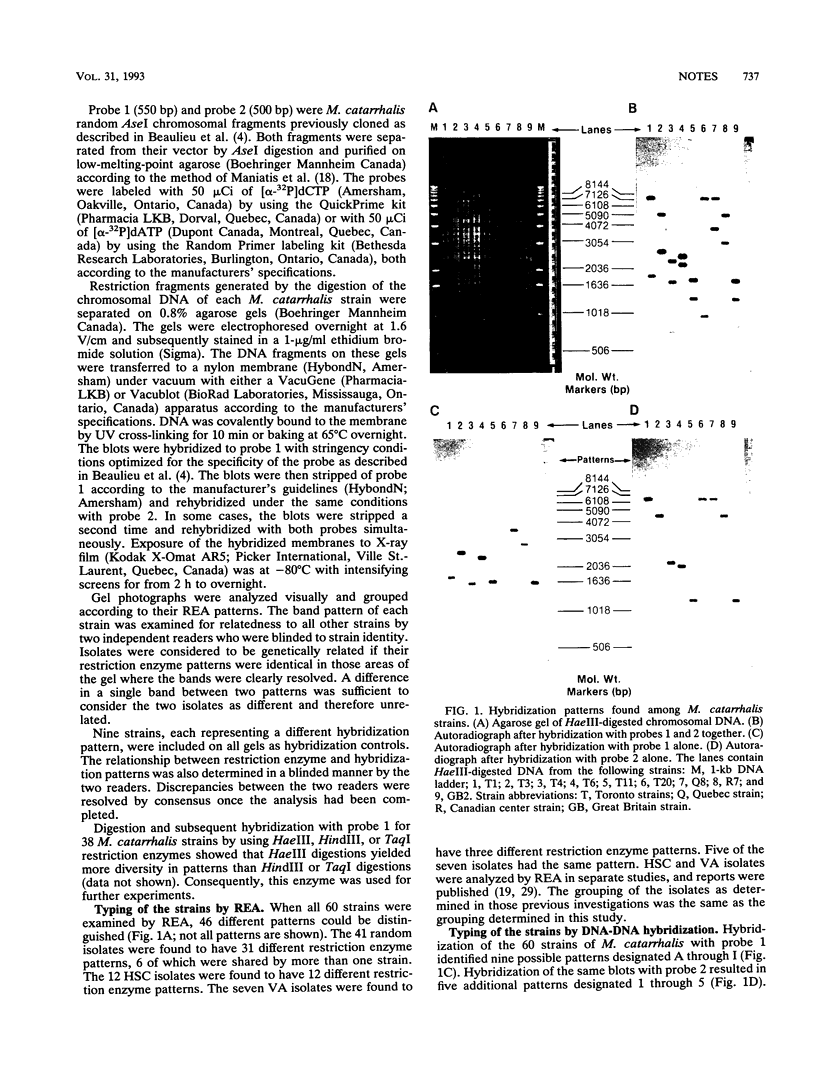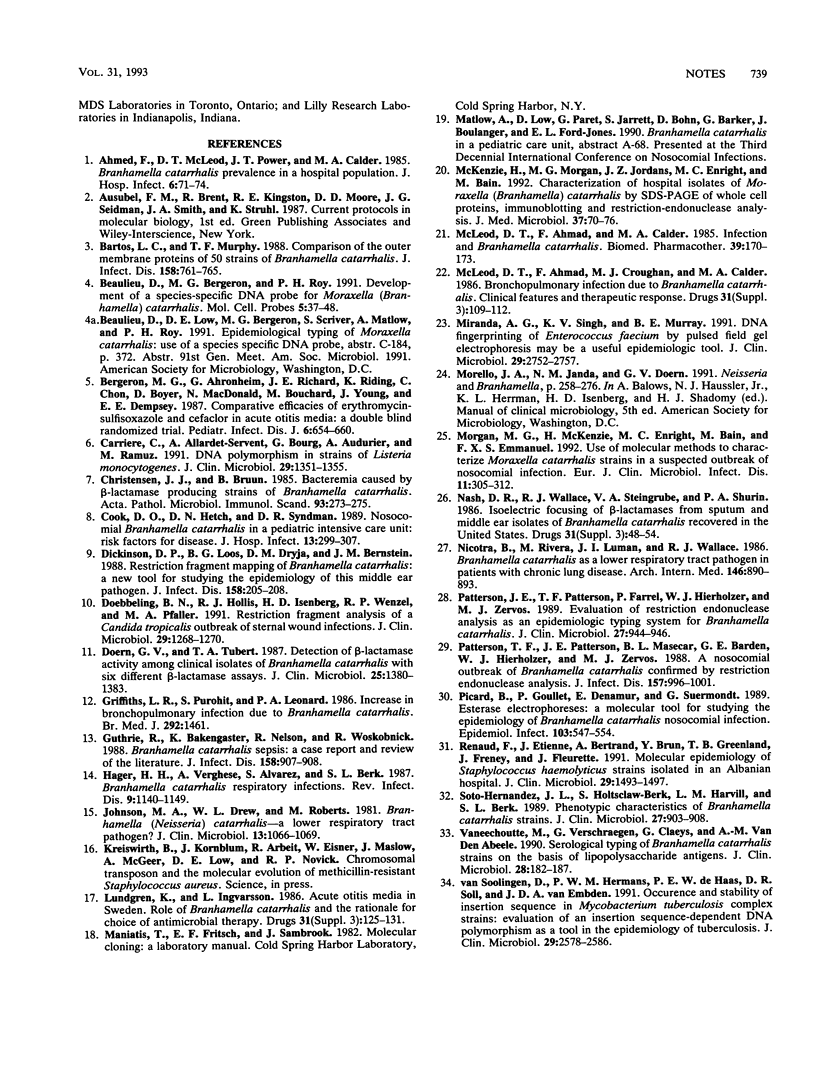Abstract
Small-fragment restriction enzyme analysis and DNA-DNA hybridization were used to compare 60 strains of Moraxella catarrhalis isolated from various geographic locations. Restriction enzyme analysis with HaeIII resulted in 46 different patterns, 7 of which were shared by more than one isolate. Hybridizations with two DNA probes resulted in 18 different patterns, 11 of which were shared by more than one isolate. Strains with the same restriction enzyme pattern always had the same hybridization pattern. However, of the 50 strains that shared the 11 hybridization patterns, 39 could be further differentiated by restriction enzyme analysis. We found that hybridization is a method that is specific for the epidemiological typing of M. catarrhalis, but because of limited sensitivity, combination with small-fragment restriction enzyme analysis may be necessary to better determine the relatedness of strains.
Full text
PDF



Images in this article
Selected References
These references are in PubMed. This may not be the complete list of references from this article.
- Ahmad F., McLeod D. T., Power J. T., Calder M. A. Branhamella catarrhalis prevalence in a hospital population. J Hosp Infect. 1985 Mar;6(1):71–74. doi: 10.1016/s0195-6701(85)80020-7. [DOI] [PubMed] [Google Scholar]
- Bartos L. C., Murphy T. F. Comparison of the outer membrane proteins of 50 strains of Branhamella catarrhalis. J Infect Dis. 1988 Oct;158(4):761–765. doi: 10.1093/infdis/158.4.761. [DOI] [PubMed] [Google Scholar]
- Beaulieu D., Bergeron M. G., Roy P. H. Development of a species-specific DNA probe for Moraxella (Branhamella) catarrhalis. Mol Cell Probes. 1991 Feb;5(1):37–48. doi: 10.1016/0890-8508(91)90036-j. [DOI] [PubMed] [Google Scholar]
- Bergeron M. G., Ahronheim G., Richard J. E., Riding K., Cron C., Bryer D., Macdonald N., Bouchard M., Young J., Dempsey E. E. Comparative efficacies of erythromycin-sulfisoxazole and cefaclor in acute otitis media: a double blind randomized trial. Pediatr Infect Dis J. 1987 Jul;6(7):654–660. doi: 10.1097/00006454-198707000-00007. [DOI] [PubMed] [Google Scholar]
- Carriere C., Allardet-Servent A., Bourg G., Audurier A., Ramuz M. DNA polymorphism in strains of Listeria monocytogenes. J Clin Microbiol. 1991 Jul;29(7):1351–1355. doi: 10.1128/jcm.29.7.1351-1355.1991. [DOI] [PMC free article] [PubMed] [Google Scholar]
- Christensen J. J., Bruun B. Bacteremia caused by a beta-lactamase producing strain of Branhamella catarrhalis. A case report. Acta Pathol Microbiol Immunol Scand B. 1985 Aug;93(4):273–275. doi: 10.1111/j.1699-0463.1985.tb02888.x. [DOI] [PubMed] [Google Scholar]
- Cook P. P., Hecht D. W., Snydman D. R. Nosocomial Branhamella catarrhalis in a paediatric intensive care unit: risk factors for disease. J Hosp Infect. 1989 Apr;13(3):299–307. doi: 10.1016/0195-6701(89)90011-x. [DOI] [PubMed] [Google Scholar]
- Dickinson D. P., Loos B. G., Dryja D. M., Bernstein J. M. Restriction fragment mapping of Branhamella catarrhalis: a new tool for studying the epidemiology of this middle ear pathogen. J Infect Dis. 1988 Jul;158(1):205–208. doi: 10.1093/infdis/158.1.205. [DOI] [PubMed] [Google Scholar]
- Doebbeling B. N., Hollis R. J., Isenberg H. D., Wenzel R. P., Pfaller M. A. Restriction fragment analysis of a Candida tropicalis outbreak of sternal wound infections. J Clin Microbiol. 1991 Jun;29(6):1268–1270. doi: 10.1128/jcm.29.6.1268-1270.1991. [DOI] [PMC free article] [PubMed] [Google Scholar]
- Doern G. V., Tubert T. A. Detection of beta-lactamase activity among clinical isolates of Branhamella catarrhalis with six different beta-lactamase assays. J Clin Microbiol. 1987 Aug;25(8):1380–1383. doi: 10.1128/jcm.25.8.1380-1383.1987. [DOI] [PMC free article] [PubMed] [Google Scholar]
- Griffiths L. R., Purohit S., Leonard P. A. Increase in bronchopulmonary infection due to Branhamella catarrhalis. Br Med J (Clin Res Ed) 1986 May 31;292(6533):1461–1461. doi: 10.1136/bmj.292.6533.1461-a. [DOI] [PMC free article] [PubMed] [Google Scholar]
- Guthrie R., Bakenhaster K., Nelson R., Woskobnick R. Branhamella catarrhalis sepsis: a case report and review of the literature. J Infect Dis. 1988 Oct;158(4):907–908. doi: 10.1093/infdis/158.4.907. [DOI] [PubMed] [Google Scholar]
- Hager H., Verghese A., Alvarez S., Berk S. L. Branhamella catarrhalis respiratory infections. Rev Infect Dis. 1987 Nov-Dec;9(6):1140–1149. doi: 10.1093/clinids/9.6.1140. [DOI] [PubMed] [Google Scholar]
- Johnson M. A., Drew W. L., Roberts M. Branhamella (Neisseria) catarrhalis--a lower respiratory tract pathogen? J Clin Microbiol. 1981 Jun;13(6):1066–1069. doi: 10.1128/jcm.13.6.1066-1069.1981. [DOI] [PMC free article] [PubMed] [Google Scholar]
- Lundgren K., Ingvarsson L. Acute otitis media in Sweden. Role of Branhamella catarrhalis and the rationale for choice of antimicrobial therapy. Drugs. 1986;31 (Suppl 3):125–131. doi: 10.2165/00003495-198600313-00028. [DOI] [PubMed] [Google Scholar]
- McKenzie H., Morgan M. G., Jordens J. Z., Enright M. C., Bain M. Characterisation of hospital isolates of Moraxella (Branhamella) catarrhalis by SDS-PAGE of whole-cell proteins, immunoblotting and restriction-endonuclease analysis. J Med Microbiol. 1992 Jul;37(1):70–76. doi: 10.1099/00222615-37-1-70. [DOI] [PubMed] [Google Scholar]
- McLeod D. T., Ahmad F., Calder M. A. Infection and Branhamella catarrhalis. Biomed Pharmacother. 1985;39(4):170–173. [PubMed] [Google Scholar]
- McLeod D. T., Ahmad F., Croughan M. J., Calder M. A. Bronchopulmonary infection due to B. catarrhalis. Clinical features and therapeutic response. Drugs. 1986;31 (Suppl 3):109–112. doi: 10.2165/00003495-198600313-00023. [DOI] [PubMed] [Google Scholar]
- Miranda A. G., Singh K. V., Murray B. E. DNA fingerprinting of Enterococcus faecium by pulsed-field gel electrophoresis may be a useful epidemiologic tool. J Clin Microbiol. 1991 Dec;29(12):2752–2757. doi: 10.1128/jcm.29.12.2752-2757.1991. [DOI] [PMC free article] [PubMed] [Google Scholar]
- Morgan M. G., McKenzie H., Enright M. C., Bain M., Emmanuel F. X. Use of molecular methods to characterize Moraxella catarrhalis strains in a suspected outbreak of nosocomial infection. Eur J Clin Microbiol Infect Dis. 1992 Apr;11(4):305–312. doi: 10.1007/BF01962069. [DOI] [PubMed] [Google Scholar]
- Nash D. R., Wallace R. J., Jr, Steingrube V. A., Shurin P. A. Isoelectric focusing of beta-lactamases from sputum and middle ear isolates of Branhamella catarrhalis recovered in the United States. Drugs. 1986;31 (Suppl 3):48–54. doi: 10.2165/00003495-198600313-00012. [DOI] [PubMed] [Google Scholar]
- Nicotra B., Rivera M., Luman J. I., Wallace R. J., Jr Branhamella catarrhalis as a lower respiratory tract pathogen in patients with chronic lung disease. Arch Intern Med. 1986 May;146(5):890–893. [PubMed] [Google Scholar]
- Patterson J. E., Patterson T. F., Farrel P., Hierholzer W. J., Jr, Zervos M. J. Evaluation of restriction endonuclease analysis as an epidemiologic typing system for Branhamella catarrhalis. J Clin Microbiol. 1989 May;27(5):944–946. doi: 10.1128/jcm.27.5.944-946.1989. [DOI] [PMC free article] [PubMed] [Google Scholar]
- Patterson T. F., Patterson J. E., Masecar B. L., Barden G. E., Hierholzer W. J., Jr, Zervos M. J. A nosocomial outbreak of Branhamella catarrhalis confirmed by restriction endonuclease analysis. J Infect Dis. 1988 May;157(5):996–1001. doi: 10.1093/infdis/157.5.996. [DOI] [PubMed] [Google Scholar]
- Picard B., Goullet P., Denamur E., Suermondt G. Esterase electrophoresis: a molecular tool for studying the epidemiology of Branhamella catarrhalis nosocomial infection. Epidemiol Infect. 1989 Dec;103(3):547–554. doi: 10.1017/s0950268800030946. [DOI] [PMC free article] [PubMed] [Google Scholar]
- Renaud F., Etienne J., Bertrand A., Brun Y., Greenland T. B., Freney J., Fleurette J. Molecular epidemiology of Staphylococcus haemolyticus strains isolated in an Albanian hospital. J Clin Microbiol. 1991 Jul;29(7):1493–1497. doi: 10.1128/jcm.29.7.1493-1497.1991. [DOI] [PMC free article] [PubMed] [Google Scholar]
- Soto-Hernandez J. L., Holtsclaw-Berk S., Harvill L. M., Berk S. L. Phenotypic characteristics of Branhamella catarrhalis strains. J Clin Microbiol. 1989 May;27(5):903–908. doi: 10.1128/jcm.27.5.903-908.1989. [DOI] [PMC free article] [PubMed] [Google Scholar]
- Vaneechoutte M., Verschraegen G., Claeys G., Van Den Abeele A. M. Serological typing of Branhamella catarrhalis strains on the basis of lipopolysaccharide antigens. J Clin Microbiol. 1990 Feb;28(2):182–187. doi: 10.1128/jcm.28.2.182-187.1990. [DOI] [PMC free article] [PubMed] [Google Scholar]
- van Soolingen D., Hermans P. W., de Haas P. E., Soll D. R., van Embden J. D. Occurrence and stability of insertion sequences in Mycobacterium tuberculosis complex strains: evaluation of an insertion sequence-dependent DNA polymorphism as a tool in the epidemiology of tuberculosis. J Clin Microbiol. 1991 Nov;29(11):2578–2586. doi: 10.1128/jcm.29.11.2578-2586.1991. [DOI] [PMC free article] [PubMed] [Google Scholar]



